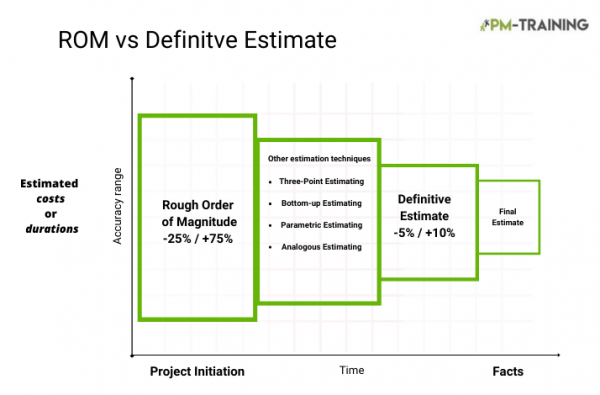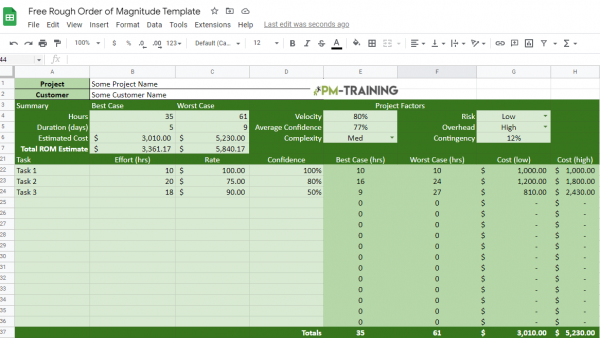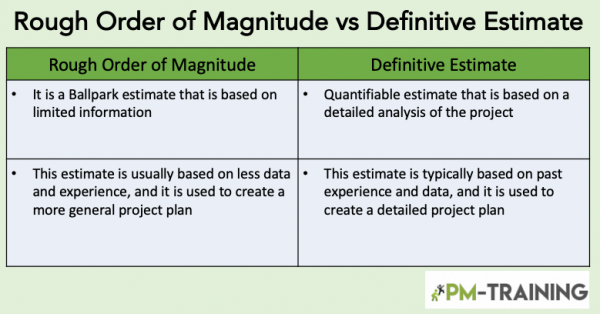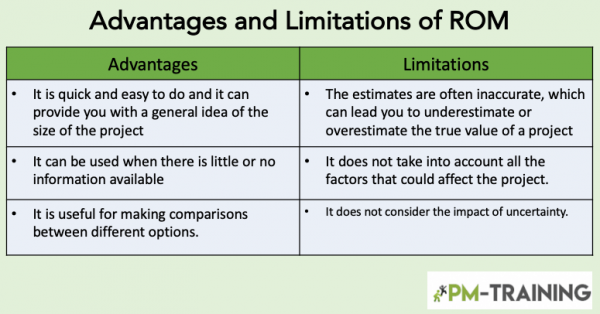Rough order of magnitude also called ROM is a technique used to estimate the value of a project. ROM is typically used when the project is in the early stages and there is not enough information to make an accurate estimate. The idea behind ROM is to come up with a “ballpark” estimate that can be used to make decisions about the project.

What is ROM in Project Management?
In project management, rough order of magnitude (ROM) is a rough estimate of the cost or size of a project. It is usually expressed as a single number that represents a range of values.
ROM estimation is a relatively simple technique that can be used to quickly estimate the likely cost or duration of a project and it is often used in the early stages of project planning when there is still uncertainty about the project’s scope and requirements.
- What is ROM in Project Management?
- ROM Example
- Ball Park Estimation
- How do you find Rough Order of Magnitude?
- How do you calculate the Rough Order of Magnitude?
- Free ROM Template
- Techniques to Find Rough Order of Magnitude
- ROM vs Definitive estimate
- When to Use ROM
- Advantages of ROM
- Limitations of ROM
- ROM in Business
- ROM in Contracting
- FAQs
According to the PMBOK, the accuracy range of a rough order estimate is typical -25% to +75%. This means that the final cost of a project could be up to 25% less than the estimate, or up to 75% more. When applying, just remember Rough Order Estimates are just that – estimates. They are not meant to be 100% accurate, but rather to give you a ballpark number to work with.
PMP Pro tip If you are working with a tight budget, you may want to err on the side of caution and estimate high. This way, you will be less likely to go over budget and cause financial difficulties for your company. On the other hand, if you have a little leeway in your budget, you may want to estimate low so that you can save
It is important to consider that the previous editions of PMBOk were +/- 50%, so if you’re taking the PMP exam, just make sure the -25%/+75% are the ones for the right answer to pass.
ROM Example
Let’s take a very quick and easy example using round figures.
- Imagine your initial software project might have a Rough Estimate (ROM) of $100 million.
That basically means that the project is estimated to cost between $50 million (-25%) and $150 million (+75%).
ROM estimation is based on the principle of Parkinson’s Law, which states that:
- “Work expands so as to fill the time available for its completion”.
This means that the more time you have to complete a project, the more likely it is to take the full amount of time.
When making decisions, consider coming up with a ballpark estimation.
Ball Park Estimation
The ROM estimate is used to give decision-makers a ballpark figure for the cost or size of the project. A ballpark estimate is a rough calculation of an expected value. This type of estimate is usually used when an exact figure is not known or when more accurate information is not available.
If you need to make a ballpark estimate, there are a few things you should keep in mind:
First, be realistic about the range of possible values.
Second, use conservative estimates rather than optimistic ones.
Third, try to use specific information and data to support your estimates whenever possible.
How do you find Rough Order of Magnitude?
Although this estimation is not an exact science, it can be a useful tool in certain situations in case you need to make a quick estimate.
To find the ROM, you first need to identify the key parameters of the problem or project. Once you have identified the key parameters, you can use a variety of methods to estimate the ROM. These methods include ballparking, using orders of magnitude, and using zeroes and extra zeroes.
When finding the Rough Order of Magnitude, you will need to first establish a baseline. This can be done by looking at similar projects or using industry standards. Once you have a baseline, you can then add or subtract based on the specific details of your project.
For example, if your project is larger in scope than the baseline, you would add to the estimate. If the project is smaller in scope, you would subtract from the estimate.
Once you have estimated the Rough Order of Magnitude, you can then use this number to start planning your project in more detail.
After you have estimated the ROM, you can then use this information to make decisions about the next steps of the project. In some cases, the ROM may be all you need to know to make a decision. In other cases, you may need to do a more detailed analysis to get to your next goal which is the Definitive Estimate.
How do you calculate the Rough Order of Magnitude?
Imagine you were asked to develop software for XYZ Co. During the initiation phase you want to know how rough the total cost of this project is going to be right?
So far, you have talked to different professionals on your team and you have compared this project to similar ones before. Based on that knowledge and research you do a ballpark estimate that gives you a total of $600,000.
Calculate Upper Boundary

Upper boundary = ROM Estimate x (1 +75%) = ROM Estimate x 1.75
Upper boundary = 600,000 x 1.75 = 10,50,000
Calculate Lower Boundary

Lower boundary = ROM Estimate x (1 -25%) = ROM Estimate x 0.75
Lower boundary = 600,000 x 0.75 = 4,50,000
Final Range
Based on the previous calculations our project range can be as high as $1,050,000 or it can be as low as $450,000,
Free ROM Template

Techniques to Find Rough Order of Magnitude
There are a variety of ways to estimate ROM, but three common methods are three-point estimation, PERT, and COCOMO.
3 Point Estimation technique
This is a method of estimating that uses three different values to represent the possible range of an estimate. You might use three values: best case, most likely cause, and worst case.
Function Point Analysis (FPA)
Typically used in the early stages of software development, before any coding. It determines The functional requirements of the system.
- Identify the function types that will be present in the system.
- Count the number of function points for each function type.
- Determine the level of complexity for each function type.
- Calculate the total number of function points
Constructive Cost Model (COCOMO)
It allows the project manager to a rough estimate of the cost, effort, and schedule when planning a new system software development activity
ROM vs Definitive estimate

As a project manager, you often need to provide an estimate of how long a project will take to complete and how much it will cost. But what is the difference between a definitive estimate and a rough order of magnitude?
When developing estimates you need to consider these ranges of accuracy
ROM – +75% and -25%
Budget estimate – This is a more exact estimate compared to ROM and can be 10% to +25% or -15% to +30% once you have allocated your Work Breakdown Structure known as WBS.
Definitive Estimate- With an accuracy range between -5% – 10%, this is the most exact type of estimate.
ROM can be used to estimate various project aspects, including project costs, project duration, and resource needs. When using it, keep in mind that the estimates produced are only approximate and should not be used as final estimates.
So which approach is better? Definitive estimate or rough order of magnitude?
The answer depends on the specific project:
If you have all the necessary information to provide a definitive estimate, then that is what you should do. But if you only have limited information, then a rough order of magnitude will suffice.
When to Use ROM
If you are working on a project and need to develop an estimate, but don’t have enough information to produce a detailed estimate, then using ROM may be a good option. Just keep in mind that the estimates produced should only be used as a starting point and should not be considered final.
Advantages of ROM
It is quick and easy to do and it can provide you with a general idea of the size of the project
It can be used when there is little or no information available
It is useful for making comparisons between different options.
Limitations of ROM
The estimates are often inaccurate, which can lead you to underestimate or overestimate the true value of a project
It does not take into account all the factors that could affect the project.
It does not consider the impact of uncertainty.

ROM in Business
In business, there is often a need to estimate future costs and revenues in order to make decisions about investments and other strategic initiatives and you can use it to quickly estimate future costs.
Rough order of magnitude (ROM) is often used in business when quick, approximated estimates are needed for planning purposes.
It is important to note that it should not be used when high accuracy is required, as the margin of error is usually quite large.
So when is it appropriate to use ROM? Some common situations where ROM is used include:
- Estimating the potential market size for a new product
- Estimating the likely costs or revenues of a new project
- Estimating the amount of time it will take to complete a project
As you can see, ROM can be quite useful in business when time is limited and precision is not of the utmost importance.
ROM in Contracting
During the selection and approval stage of a project, a ROM estimate can be useful when you are trying to determine if a project is feasible or when you need to make a decision about whether to move forward with a project. It can also be helpful in negotiating with vendors or contractors.
Remember, if you are given a rough estimate that is outside of the -25/+70% range, it will be a good idea to get a second opinion. A contractor may be trying to take advantage of you, or they may simply be inexperienced. Either way, it is best to be safe and get a second opinion before proceeding.
FAQs
Why is ROM important?
ROM estimation is a valuable tool for project managers. It can help you quickly assess a project and determine if it is worth pursuing. It can also help you get a better understanding of the size and scope of a project.
What are the benefits of using ROM?
The main benefit of using the Rough Order of Magnitude is that it can provide a quick estimate that can be used to make decisions.
What is Ballpark Estimation?
A ballpark estimate is a rough calculation of an expected value for a project.
What does ROM mean in Business?
It is a general estimation of future costs by using past data and trends, especially with similar services or vendors for planning projects.
When to use ROM?
The Rough Order of Magnitude is a way of estimating future costs by using past data and trends. It is typically used when there is limited data available or when time is of the essence.
